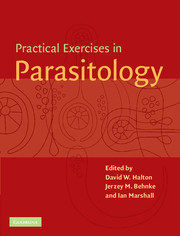Book contents
- Frontmatter
- Contents
- List of contributors
- Preface
- General advice
- 1 Observational Exercises on Parasites
- A Local wild and domestic hosts as sources of parasites
- 1.1 Parasites of the earthworm: Monocystis (Protozoa) and Rhabditis (Nematoda)
- 1.2 Parasites of marine molluscs (Littorina)
- 1.3 Parasites offish: (a) Whiting and Diclidophora merlangi (Monogenea)
- 1.4 Parasites of fish: (b) Plaice/flounder and Lepeophtheirus pectoralis (Copepoda)
- 1.5 Parasites of domestic livestock: (a) Pig and Ascaris suum (Nematoda)
- 1.6 Parasites of domestic livestock: (b) Sheep and Fasciola hepatica (Trematoda)
- 1.7 Parasites of crops: Potato cyst nematode (PCN) Globodera pallida (Nematoda)
- B Laboratory maintained species
- 2 Ecology
- 3 Physiology and Biochemistry
- 4 Pathology and Immunology
- 5 Chemotherapy
- 6 Molecular Parasitology
- 7 Behaviour
- Appendix 1 Reagent index
- Appendix 2 UK suppliers
- Appendix 3 US suppliers
- Index
1.6 - Parasites of domestic livestock: (b) Sheep and Fasciola hepatica (Trematoda)
Published online by Cambridge University Press: 05 June 2012
- Frontmatter
- Contents
- List of contributors
- Preface
- General advice
- 1 Observational Exercises on Parasites
- A Local wild and domestic hosts as sources of parasites
- 1.1 Parasites of the earthworm: Monocystis (Protozoa) and Rhabditis (Nematoda)
- 1.2 Parasites of marine molluscs (Littorina)
- 1.3 Parasites offish: (a) Whiting and Diclidophora merlangi (Monogenea)
- 1.4 Parasites of fish: (b) Plaice/flounder and Lepeophtheirus pectoralis (Copepoda)
- 1.5 Parasites of domestic livestock: (a) Pig and Ascaris suum (Nematoda)
- 1.6 Parasites of domestic livestock: (b) Sheep and Fasciola hepatica (Trematoda)
- 1.7 Parasites of crops: Potato cyst nematode (PCN) Globodera pallida (Nematoda)
- B Laboratory maintained species
- 2 Ecology
- 3 Physiology and Biochemistry
- 4 Pathology and Immunology
- 5 Chemotherapy
- 6 Molecular Parasitology
- 7 Behaviour
- Appendix 1 Reagent index
- Appendix 2 UK suppliers
- Appendix 3 US suppliers
- Index
Summary
Aims and objectives
This practical is designed to demonstrate:
Part of the life cycle of a parasite of medical and veterinary significance, the common liver fluke Fasciola hepatica, from infection to maturation.
The general body plan of an acoelomate flatworm and its adaptations for parasitism with respect to the surface tegument, digestive, excretory and reproductive systems.
Introduction
F. hepatica, the common liver fluke, is a platyhelminth digenean trematode. The life cycle of the liver fluke (Fig. 1.6.1) is indirect and includes freshwater snails as intermediate hosts; in the UK this is the amphibious mud snail, Lymnaea truncatula. Fasciola is an example of a ‘zoonosis’; i.e. an organism that is fully infectious to humans but which is maintained in the ecosystem by a range of other animals, including rabbits, acting as definitive hosts. F. hepatica occurs widely in Eurpoe. It causes fasciolosis or ‘liver rot’, mainly in cattle, sheep and goats. It is not usually an important parasite of humans, with the exception, for example, of parts of Latin America. The related liver fluke, F. gigantica, is an important zoonosis and is found in humans and domestic and wild ruminants in Africa and the orient.
Liver fluke causes serious veterinary problems in livestock where the disease varies from year to year depending largely on climatic conditions, such as increased temperature and rainfall in June and July. Ecological studies in the UKhave enabled a valuable forecasting system to be developed to warn farmers when to expect outbreaks of the disease (Ollerenshaw & Rollands, 1959).
- Type
- Chapter
- Information
- Practical Exercises in Parasitology , pp. 53 - 62Publisher: Cambridge University PressPrint publication year: 2001
- 1
- Cited by



